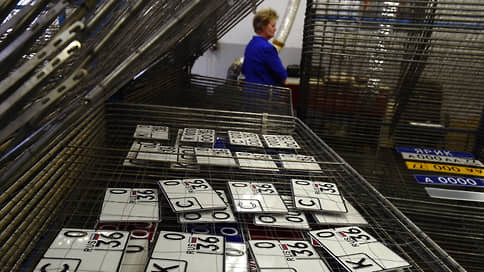RAF argues with Rosstandart about simplifying the rules for installing square license plates
[ad_1]

Representatives of the Russian Automobile Federation (RAF) are lobbying the authorities to liberalize the rules for installing non-standard (type 1A, also called “square”) license plates, which came into use three years ago. These are registration plates for standard mounting points on Japanese, American and other cars. Currently they are only allowed to be placed in the rear bumper area. The restriction needs to be lifted, the RAF believes. Rosstandart did not support the proposal.
Type 1A license plates were introduced by amendments to GOST-50577 on August 4, 2020, which made life easier for owners of Japanese and American cars. They can now install state registration marks without any modifications in the standard places provided by the manufacturer. Standard rectangular ones (type 1) had to be bent or adapters used during installation. At the same time, GOST reported that installation of “square” license plates is possible only in the area of the rear bumper. The fine for violation is 500 rubles. The reason for the restriction was not explained in the document.
Deputy Chairman of the RAF Classic Car Committee, license plate collector Petr Shlyakhin sent a letter to Rosstandart and the technical committee at the Road Safety agency (Mr. Shlyakhin is its member; the committee also includes representatives of the State Traffic Safety Inspectorate and the Scientific Center for Road Safety of the Ministry of Internal Affairs), proposing to allow the installation Type 1A numbers not only in the rear, but also in the front of the car.
Created in 1991, the RAF is the successor to the USSR Automobile Sports Federation. The organization unites motorsports athletes, coaches, judges, antique car restorers, etc. The RAF is headed by the former head of the Russian State Traffic Safety Inspectorate, managing director of Rostec for infrastructure projects, Viktor Kiryanov.
Petr Shlyakhin gives a number of arguments to substantiate his position. He, in particular, points to vehicles with a manufacturer-installed winch on the front bumper (for example, Nissan Patrol from 1987–1997): the standard rectangular license plate must be mounted on the side, it protrudes beyond the car and can injure pedestrians. In other cases, the number may overlap the parking sensors. Moreover, there are models of Japanese cars in which from the factory the front mount comes with a square number, and the normal one closes the engine ventilation when installed. “This impairs engine cooling, which can lead to increased emissions of harmful substances,” explains Pyotr Shlyakhin. On some foreign cars, the rectangular number sometimes covers the external light fixtures.
The Union of Manufacturers of State Registration Vehicle Markings supported the proposal, noting that despite the ban, a large number of cars with square numbers on the front are already moving on the roads. “This is especially common in Vladivostok,” the organization says. “The fact that this is actually illegal does not bother drivers, and the traffic police, apparently, does not find fault. Why not amend GOST, legalizing the existing practice?” According to the traffic police, more than 3 million right-hand drive passenger cars are registered in Russia, most of them in the Far East.
“Taking into account the recent import of thousands of right-hand drive cars, the issue is more acute than before,” Vice-President of the National Automobile Union Anton Shaparin supported the initiative. “And there will be more and more of them, since these are cars in the lower price segment – due to the cheap customs clearance and small engines.” In the first half of the year, we note that Vladivostok customs processed more than 130 thousand cars imported for personal use from abroad (80% from Japan), twice as much as a year earlier. However, from August 9, Japan banned the import into the Russian Federation of passenger cars with engines larger than 1.9 liters: the total volume of Japanese auto exports to Russia, according to the country’s Ministry of Finance, fell by 42.5% in August.
Rosstandart told Kommersant that the proposal was considered “inappropriate.” The design of “most” cars allows the installation of a regular rectangular license plate, the use of adapters and frames is “allowed”, and when installing a square state registration plate, its illumination is “not provided,” the department explained. “There is no backlight on the license plates in front, this argument looks strange,” notes Anton Shaparin.
The OKO association (unites camera manufacturers and operators) called the RAF idea “premature.” “Cars with such license plates are rare on Russian roads,” the organization says. “Neural networks used in modern cameras can be taught to recognize anything, but this requires time and several hundred thousand reference images.”
[ad_2]
Source link








